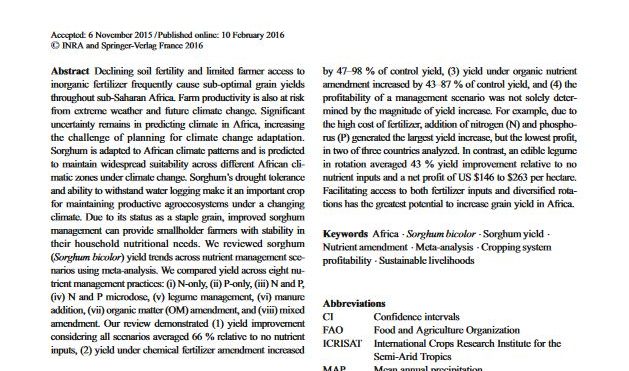Declining soil fertility and limited farmer access to inorganic fertiliser frequently cause sub-optimal grain yields throughout sub-Saharan Africa. Farm productivity is also at risk from extreme weather and future climate change. Significant uncertainty remains in predicting climate in Africa, increasing the challenge of planning for climate change adaptation. Sorghum is adapted to African climate patterns and is predicted to maintain widespread suitability across different African climatic zones under climate change. Sorghum’s drought tolerance and ability to withstand water logging make it an important crop for maintaining productive agroecosystems under a changing climate. Due to its status as a staple grain, improved sorghum management can provide smallholder farmers with stability in their household nutritional needs. We reviewed sorghum (Sorghum bicolor) yield trends across nutrient management scenarios using meta-analysis. We compared yield across eight nutrient management practices: (i) N-only, (ii) P-only, (iii) N and P, (iv) N and P micro dose, (v) legume management, (vi) manure addition, (vii) organic matter (OM) amendment, and (viii) mixed amendment. Our review demonstrated (1) yield improvement considering all scenarios averaged 66% relative to no nutrient inputs, (2) yield under chemical fertiliser amendment increased by 47–98% of control yield, (3) yield under organic nutrient amendment increased by 43–87% of control yield, and (4) the profitability of a management scenario was not solely determined by the magnitude of yield increase. For example, due to the high cost of fertiliser, addition of nitrogen (N) and phosphorus (P) generated the largest yield increase, but the lowest profit, in two of three countries analysed. In contrast, an edible legume in rotation averaged 43% yield improvement relative to no nutrient inputs and a net profit of US $146 to $263 per hectare. Facilitating access to both fertiliser inputs and diversified rotations has the greatest potential to increase grain yield in Africa.
Region: Africa
Date published:
2016
Published by:
Agronomy for Sustainable Development
Type of resource:
Journal article
Resource topic:
Sorghum
Project/Programme: Not specific
Pest/Disease: Not specific
Pages:
19
File type:
External link (1.36 MB)




